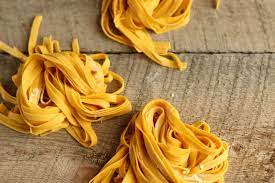Today, I made pasta by hand for breakfast and lunch. It was a bit of an experiment to see if I could make it. and I could indeed. The pasta was easy to make. Where I failed actually was in completing the dish itself.
As I said, handmade pasta is easy to make. There are a ton of recipes online so I will not write down one right now. This is more like a log of what worked and what did not.
The pasta I was making was egg fettucini. It was chosen for the simple reason that I could roll out the dough as thin as I could and cut it into strips. I actually used 2 cups of semolina (sooji) for the dough and added two eggs (one egg per serving) and knead it till a relatively tight dough formed. This is important, as otherwise the noodles would not remain intact as they cook. Then I let the dough rest for 1/2 an hour under a kitchen towel. So far so good.
Meanwhile I heated up oil in a pan and added some finely chopped garlic and some crushed peppercorns, frying in low heat. Once the garlic started to go fragrant I added one cup full of tomato puree and let it cook on a low flame. The idea was to reduce the sauce till it would coat the noodles. It is here that I think I missed a step. The tomato puree was a acidic and it needed some sort of fat to balance it out. I should have added in some butter halfway through cooking the sauce.

Handmade Pasta
I rolled out the dough as thin as I could using a rolling pin and let me tell you, if you do this regularly, you won’t need an upper body workout on the gym anymore. It is hard work, as we are working with a low hydration dough. Then I sprinkled some more semolina on the flattened dough and rolled it up into a cylinder. Then using a sharp knife I cut the rolled dough radially into strips, and voila! I had fettucini at hand. However, if you do this regularly, better get yourself a pasta roller. It would save you a lot of effort.
You can read our another post on Bali Yatra: The Celebration of Maritime Splendor
I simply dumped the noodles in boiling salted water and let the noodles cook for 5 minutes. The reason the noodles took so long to cook was because they were relatively thick and I did not want undercooked noodles.
Finally, I drained the noodles and dumped the whole lot into the sauce which was still cooking. As I said earlier, a knob of butter would have rounded up the dish. As it was the whole thing ended up being a bit one note. What it was however was filling, the pasta had absorbed the cooking water and swelled in size. The dish was tangy from the tomatoes but the taste was a little overpowering. The next time, I’ll add more garlic and black pepper.
The next time I make homemade pasta, I’d probably go for some dried herbs like oregano or basil. Well, lesson learnt and ingredients added to the shopping list. I will post the results of that experiment as soon as it gets done.
Dive into the fascinating world of pasta-making with the Odia book, “Handmade Pasta: Success and Failure.” This delightful book takes readers on a rollercoaster journey of experimenting with handmade pasta, showcasing the joys and challenges of crafting this beloved Italian delicacy.
“Handmade Pasta: Success and Failure” is a captivating ode to the artistry and creativity involved in pasta-making. The book introduces readers to the basic techniques, ingredients, and tools necessary to embark on this culinary adventure. It unfolds the story of passionate individuals who have dedicated themselves to perfecting the art of handmade pasta, sharing their experiences, tips, and tricks along the way.
With detailed descriptions and vivid imagery, the book transports readers to the heart of Italy’s pasta-making culture. It explores the different shapes, flavors, and textures that can be achieved, encouraging readers to experiment and create their own signature pasta dishes. From classic favorites like spaghetti and fettuccine to unique shapes and fillings, “Handmade Pasta: Success and Failure” is a treasure trove of inspiration for pasta enthusiasts.
What sets this book apart is its honest and relatable approach. It embraces the fact that pasta-making is not always smooth sailing. Each chapter dives into the triumphs and tribulations faced by pasta enthusiasts, sharing stories of failed attempts and the valuable lessons learned along the way. It highlights that true mastery comes from embracing both success and failure in the pursuit of culinary excellence.
“Handmade Pasta: Success and Failure” goes beyond being a mere recipe book by weaving in personal narratives, anecdotes, and heartfelt reflections. It becomes a companion, cheering readers on through their pasta-making endeavors and assuring them that perseverance and a sprinkle of humor can turn even the most challenging moments into valuable learning experiences.
